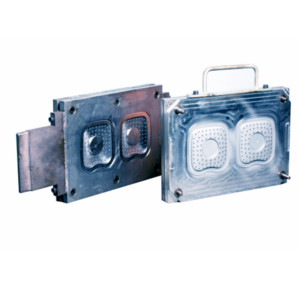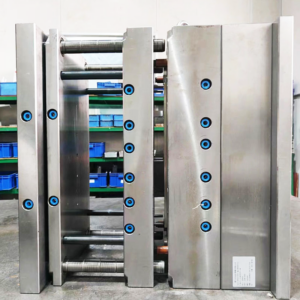Compression molding is a method used to create parts by placing a specific amount of material into a mold, closing the mold, and applying heat and pressure. This material is called a charge or load. The mold is usually pre-heated to make the material flow more easily and fill the mold as it’s compressed. Once molding is done, the part is cooled, removed from the mold, and any excess material is trimmed off.
Compression molding is often used for larger or heavier parts, especially those that are flat or have simple shapes. However, it can also be used for smaller parts and can create features like threads, holes, and grooves. It can work with various materials like plastic, rubber, and composites, but it’s typically used for making a moderate number of parts.
Compression molds have two parts: a movable top (the core) and a fixed bottom (the cavity). These are usually made of aluminum or steel. The parting line is where the two mold halves meet. Some molds have just one cavity, but most have multiple cavities to speed up production. To release the parts, molds may use ejector pins and sliders, or parts may be removed manually.
Compression molds are usually made by machining hardened steel blocks. This can be done manually with milling and drilling or with automated machinery. They can also be die-cast, but this still requires CNC machining. Sometimes, 3D-printed inserts are used to reduce costs, but they don’t last as long or meet the same tolerances as metal molds.
There are three main types of compression molds:
Flash molds: These are the simplest and cheapest to produce. Excess material escapes between the mold halves during compression, so they’re often used with less expensive materials.
Positive molds: These cost more and require accurate measurements for the charge. They’re used when precise part density is needed or when parts are made from expensive materials.
Semi-positive molds: These are the most expensive but offer a middle ground between flash and positive molds. They don’t require precise measurements, but using too much material can cause it to escape between the mold halves.
Our molds are designed by a professional team and work closely with the R&D team. The size, shape, and performance of the manufactured molds all meet customer requirements. So if you need precision molds, please contact our team.


The compression molding process involves several steps:
Prepare the charge: Measure the material carefully to avoid excess or shortage.
Load the mold: Place the charge in the cavity.
Apply heat and pressure: Close the mold and heat the material to make it flow.
Cool or cure the part: Harden the material by cooling or using catalysts.
Release the part: Open the mold and remove the part, either manually or with automated equipment.
Trim or de-flash the part: Remove any excess material.
Clean the mold: Remove any remaining material and apply a release agent to prevent sticking in future cycles.
Compression molding has several advantages, including lower tooling costs, the ability to use heavy or hard-to-flow materials, and parts free of flow lines and residual stresses. However, it’s not suitable for complex parts or sharp edges, and longer cycle times can add to costs.
Our compression molding process is standardized, our operations are professional, and with a complete production workshop, we maintain a satisfactory production capacity.
![]()
![]()
At YJCPolymer, we offer compression molding services along with other manufacturing options like 3D printing and low-volume injection molding. If you’re not sure which method is best for your project, we can help you decide. Just create a free account and upload your design to get started.